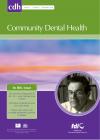Community Dental Health

- Cover Date:
- September 2010
- Print ISSN:
- 0265 539X
- Vol:
- 27
- Issue:
- 3
A 6-year longitudinal study of caries in teenagers and the effect of “dropouts†on the findings
Objectives: To investigate attrition of subjects in a longitudinal study of caries. Design: A radiographic study of caries and caries-associated factors was carried out in subjects, initially aged 14 years, and followed-up for six years. Attrition of subjects occurred at the last stage of the study. Setting: A nationwide survey of subjects living in fishing, rural farming, and urban communities in Iceland. Sample and Methods: A sub-sample of the nationwide random sample comprising 150 subjects was investigated using bitewing radiographs and a structured questionnaire to determine caries-risk factors. Subjects were re-examined at 16 years and 20 years using the same methods. Results: Mean caries increment from 14-16 years was 3.0 lesions (1.5 lesions/subject/year) but reduced to 2.6 lesions (0.7 lesions/subject/ year) by 20y. The proportion of subjects found to be caries-free at 14 years, 16 years and 20 years, was 29%, 17% and 10%, respectively. “Dropouts†from this study occurred mostly after 16 years. Analysis of subjects dropping out showed that they were least likely to be from the rural farming community but most likely from the fishing community. Those dropping out attended their dentist less frequently, had a higher consumption of carbonated drinks and a higher prevalence and incidence of caries by 16 years. Conclusions Subjects with high-risk behaviours, or residents in a fishing community were more likely to drop out of the study. Recognised advantages of conducting longitudinal studies of caries may, therefore, be lost.
Key words: Adolescents, caries risk factors, dental caries, Iceland, longitudinal study.
- Article Price
- £15.00
- Institution Article Price
- £
- Page Start
- 172
- Page End
- 177
- Authors
- I.B. Ãrnadóttir, W.P. Holbrook, H. Ãgústsdóttir, S. R. Sæmundsson
Articles from this issue
- Title
- Pg. Start
- Pg. End
- Plaque, caries level and oral hygiene habits in young patients receiving orthodontic treatment
- 133
- 138
- Oral health and treatment needs of institutionalized chronic psychiatric patients in Istanbul, Turkey.
- 151
- 157
- Social differences in tooth decay occurrence in a sample of children aged 3 to 5 in North-East Italy
- 163
- 166
- Child oral health concerns amongst parents and primary care givers in a Sure Start Local Programme
- 167
- 171
- A 6-year longitudinal study of caries in teenagers and the effect of “dropouts†on the findings
- 172
- 177
